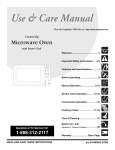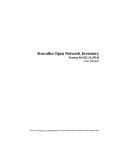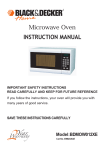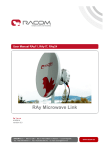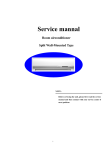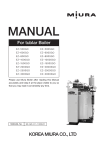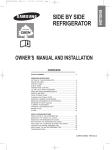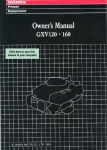Download Sharp R-222R Specifications
Transcript
ENGLISH Important R-G221VN R-G222VN R-G223VN 800 W MICROWAVE OVEN WITH GRILL OPERATION MANUAL This operation manual contains important information which you should read carefully before using your microwave oven. IMPORTANT: There may be a serious risk to health if this operation manual is not followed or if the oven is modified so that it operates with the door open. CONTENTS OPERATION MANNAL CONTENTS............................................................................................................................................................................................ 1 SPECIFICATIONS ................................................................................................................................................................................. 1 OVEN AND ACCESSORIES ............................................................................................................................................................... 2 CONTROL PANEL ................................................................................................................................................................................ 3 IMPORTANT SAFETY INSTRUCTIONS ...................................................................................................................................... 4-6 INSTALLATION..................................................................................................................................................................................... 6 MICROWAVE AND GRILL POWER LEVELS ................................................................................................................................... 7 MICROWAVE AND GRILL COOKING .............................................................................................................................................. 7 DEFROSTING GUIDE ......................................................................................................................................................................... 8 SUITABLE OVENWARE ...................................................................................................................................................................... 8 CARE AND CLEANING ......................................................................................................................................................................9 TROUBLESHOOTING ........................................................................................................................................................................10 SPECIFICATIONS Model name: AC Line Voltage AC Power required: Output power: R-G221VN,R-G222VN,R-G223VN : 230 V, 50 Hz single phase : 1270 W : 800 W : 1000 W : less than 1.0 W : 2450 MHz : 440 x 258 x 340 : 306 x 208 x 307 : 20 litres* : ø 255 mm : approx. 11.4 kg Microwave Microwave Grill Off Mode (Energy Save Mode) Microwave Frequency Outside Dimensions (W) x (H x (D) mm Cavity Dimensions (W) x (H) x (D) mm * Oven Capacity Turntable Weight * Internal capacity is calculated by measuring maximum width, depth and height. Actual capacity for holding food is less. AS PART OF A POLICY OF CONTINUOUS IMPROVEMENT, WE RESERVE THE RIGHT TO ALTER DESIGN AND SPECIFICATIONS WITHOUT NOTICE. E-1 OVEN 1. Door 2. Door hinges 3. Oven lamp 4. Waveguide cover (DO NOT REMOVE) 5. Control knob 6. Coupling 7. Door latches 8. Oven cavity 9. Door seals and sealing surfaces 10. Door safety latches 11. Ventilation openings 12. Outer cabinet 13. Power supply cord 14. Door opening button Hub (inside) 15. Turntable (glass) 17. Coupling 16. Turntable support ACCESSORIES: Check to make sure the following accessories are provided: (15) Turntable (16) Turntable support (17) Coupling (18) Rack Place the turntable support in the centre of the oven floor so that it can freely rotate around the coupling. Then place the turntable on to the turntable support so that it locates firmly into the coupling. To avoid turntable damage, ensure dishes and containers are lifted clear of the turntable rim when removing them from the oven. NOTE: When you order accessories, please mention two items: part name and model name to your dealer or SHARP authorised service agent. 18. Rack NOTES: • The waveguide cover is fragile. Care should be taken when cleaning inside the oven to ensure that it is not damaged. • Always operate the oven with the turntable and turntable support fitted correctly. This promotes thorough, even cooking. A badly fitted turntable may rattle, may not rotate properly and could cause damage to the oven. • All food and containers of food are always placed on the turntable for cooking. • The turntable rotates clockwise or anti-clockwise. The rotary direction may change each time you start the oven. This does not affect cooking performance. • After cooking fatty foods without a cover, always clean the cavity and especially the grill heating element thoroughly, these must be dry and free from grease. Built-up grease may overheat and begin to smoke or catch fire. WARNING: This symbol means that the surfaces are liable to get hot during use. The door, outer cabinet, oven cavity, accessories and dishes will become very hot during operation. To prevent burns, always use thick oven gloves. E-2 ENGLISH OVEN AND ACCESSORIES CONTROL PANEL 1. POWER MICROWAVE POWER CONTROL knob Power level High=800 WATT M.High=620 WATT Med=440 WATT M.Low=260 WATT Low=130 WATT Combi.1 = 80% grill 20% micro. Combi.2 = 70% grill 30% micro. Combi.3 = 60% grill 40% micro. Grill = 100% grill 2. TIMER DEFROST(kg) TIMER/ DEFROST GUIDE knob (0-35 Mins/ 0.2 – 1.0 kg) The TIMER/ DEFROST GUIDE features two scales. The outer scale is for defrosting according to weight in kg. The inner scale is used for setting the time. E-3 IMPORTANT SAFETY INSTRUCTIONS IMPORTANT SAFETY INSTRUCTIONS: READ CAREFULLY AND KEEP FOR FUTURE REFERENCE The microwave oven should not be left unattended during operation. Power levels that are too high, or cooking times that are too long, may overheat foods resulting in a fire. This oven is designed to be used on a countertop only. It is not designed to be built into a kitchen unit. Do not place the oven in a cabinet. The electrical outlet must be readily accessible so that the unit can be unplugged easily in an emergency. The AC power supply must be 230V, 50Hz, with a minimum 10A distribution line fuse, or a minimum 10A distribution circuit breaker. A separate circuit serving only this appliance should be provided. Do not place the oven in areas where heat is generated. For example, close to a conventional oven. Do not install the oven in an area of high humidity or where moisture may collect. Do not store or use the oven outdoors. If smoke is observed, switch off or unplug the oven and keep the door closed in order to stifle any flames. Use only microwave-safe containers and utensils. See Page GB-14. Utensils should be checked to ensure that they are suitable for use in microwave ovens. When heating food in plastic or paper containers, keep an eye on the oven due to the possibility of ignition. Clean the waveguide cover, the oven cavity, the turntable and turntable support after use. These must be dry and free from grease. Builtup grease may overheat and begin to smoke or catch fire. WARNING: Do not operate the oven if it is damaged or malfunctioning. Check the following before use: a) The door; make sure the door closes properly and ensure it is not misaligned or warped. b) The hinges and safety door latches; check to make sure they are not broken or loose. c) The door seals and sealing surfaces; ensure that they have not been damaged. d) Inside the oven cavity or on the door; make sure there are no dents. e) The power supply cord and plug; ensure that they are not damaged. If the door or door seals are damaged, the oven must not be operated until it has been repaired by a competent person. Never adjust , repair or modify the oven yourself. It is hazardous for anyone other than a competent person to carry out any service or repair operation which involves the removal of a cover which gives protection against exposure to microwave energy. ENGLISH See the corresponding hints in the operation manual. To avoid the possibility of injury To avoid the danger of fire. Do not operate the oven with the door open or alter the door safety latches in any way. Do not operate the oven if there is an object between the door seals and sealing surfaces. E-4 Individuals with PACEMAKERS should check with their doctor or the manufacturer of the pacemaker for precautions regarding microwave ovens. To avoid the possibility of electric shock Under no circumstances should you remove the outer cabinet. Never spill or insert any objects into the door lock openings or ventilation openings. In the event of a spill, turn off and unplug the oven immediately, and call an authorised SHARP service agent. Do not immerse the power supply cord or plug in water or any other liquid. Do not let the power supply cord hang over the edge of a table or work surface. ENGLISH Do not place flammable materials near the oven or ventilation openings. Do not block the ventilation openings. Remove all metallic seals, wire twists, etc., from food and food packages. Arcing on metallic surfaces may cause a fire. Do not use the microwave oven to heat oil for deep frying. The temperature cannot be controlled and the oil may catch fire. To make popcorn, use only special microwave popcorn makers. Do not store food or any other items inside the oven. Check the settings after you start the oven to ensure the oven is operating as desired. To avoid overheating and fire, special care must be taken when cooking or reheating foods with a high sugar or fat content, for example, Sausage rolls, Pies or Christmas pudding. Do not allow grease or dirt to build up on the door seals and adjacent parts. Clean the oven at regular intervals and remove any food deposits. Follow the instructions for "Care and Cleaning" on page GB-15. Failure to maintain the oven in a clean condition could lead to a deterioration of the surface that could adversely affect the life of the appliance and possibly result in a hazardous situation. IMPORTANT SAFETY INSTRUCTIONS Keep the power supply cord away from heated surfaces, including the rear of the oven. Keep the appliance and its cord out of reach of children less than 8 years. Do not attempt to replace the oven lamp yourself or allow anyone who is not an electrician authorised by SHARP to do so. If the oven lamp fails, please consult your dealer or an authorised SHARP service agent. If the power supply cord of this appliance is damaged, it must be replaced with a special cord. The exchange must be made by an authorised SHARP service agent. To avoid the possibility of explosion and sudden boiling: WARNING: Liquids and other foods must not be heated in sealed containers since they are liable to explode. Microwave heating of beverages can result in delayed eruptive boiling, therefore care must be taken when handling the container. Never use sealed containers. Remove seals and lids before use. Sealed containers can explode due to a build up of pressure even after the oven has been turned off. Take care when microwaving liquids. Use a wide mouthed container to allow bubbles to escape. Never heat liquids in narrow necked containers such as baby bottles, as this may result in the contents erupting from the container when heated and cause burns. To prevent sudden eruption of boiling liquid and possible scalding: 1. Do not use excessive amount of time. 2. Stir liquid prior to heating/reheating. 3. It is advisable to insert a glass rod or similar utensil (not metal) into the liquid whilst reheating. 4. Let liquid stand for at least 20 seconds in the oven at the end of cooking time to prevent delayed eruptive boiling. Do not cook eggs in their shells, and whole hard boiled eggs should not be heated in microwave ovens since they may explode even af ter microwave cooking has ended. To cook or reheat eggs which have not been scrambled or mixed, pierce the yolks and the whites, or the eggs may explode. Shell and slice hard boiled eggs before reheating them in the microwave oven. Pierce the skin of such foods as potatoes, sausages and fruit before cooking, or they may explode. To avoid the possibility of burns WARNING: The contents of feeding bottles and baby food jars must be stirred or shaken and the temperature checked before consumption, in order to avoid burns. Use pot holders or oven gloves when removing food from the oven to prevent burns. Always open containers, popcorn makers, oven cooking bags, etc., away from the face and hands to avoid steam burns and eruption of boiling. E-5 To avoid burns, always test food temperature and stir before serving and pay special attention to the temperature of food and drink given to babies, children or the elderly. Accessible parts may become hot during use. Young children should be kept away. Temperature of the container is not a true indication of the temperature of the food or drink; always check the food temperature. Always stand back from the oven door when opening it to avoid burns from escaping steam and heat. Slice stuffed baked foods after heating to release steam and avoid burns. Keep children away from the door to prevent them burning themselves. To avoid misuse by children WARNING: Only allow children aged from 8 years and above to use the oven without supervision when adequate instructions have been given so that the child is able to use the oven in a safe way and understands the hazards of improper use. This appliance is not intended for use by persons (including children) with reduced physical, sensory or mental capabilities, or lack of experience and knowledge, unless they have been given supervision or instruction concerning use of the appliance by a person responsible for their safety. Children should be supervised to ensure that they do not play with the appliance. Do not lean or swing on the oven door. Do not play with the oven or use it as a toy. Children should be taught all important safety instructions: use of pot holders, careful removal of food coverings; paying special attention to packaging (e.g. self-heating materials) designed to make food crisp, as they may be extra hot. Other warnings Never modify the oven in any way. Do not move the oven while it is in operation. This appliance is intended to be used in household and similar applications such as: • staff kitchen areas in shops, offices and other working environments; • farm houses; • by clients in hotels, motels and other residential environments; • bed and breakfast type environments. This oven is for home food preparation only and may only be used for cooking food. It is not suitable for commercial or laboratory use. To promote trouble-free use of your oven and avoid damage. Never operate the oven when it is empty. When using a browning dish or self-heating material, always place a heat-resistant insulator such as a porcelain plate under it to prevent damage to the turntable and turntable support due to heat stress. The preheating time specified in the dishes instructions must not be exceeded. Do not use metal utensils, which reflect microwaves and may cause electrical arcing. Do not put cans in the oven. Use only the turntable and the turntable support designed for this oven. Do not operate the oven without the turntable. To prevent the turntable from breaking: (a) Before cleaning the turntable with water, leave the turntable to cool. (b) Do not put hot foods or hot utensils on a cold turntable. (c) Do not put cold foods or cold utensils on a hot turntable. Do not place anything on the outer cabinet during operation. NOTE: If you are unsure how to connect your oven, please consult an authorised, qualified electrician. Neither the manufacturer nor the dealer can accept any liability for damage to the oven or personal injury resulting from failure to observe the correct electrical connection procedure. Water vapour or drops may occasionally form on the oven walls or around the door seals and sealing surfaces. This is a normal occurrence and is not an indication of microwave leakage or a malfunction. This symbol means that the surfaces are liable to get hot during use. INSTALLATION 1. Remove all packing materials from the inside of the oven cavity and remove any protective film found on the microwave oven cabinet surface. 2. Check the oven carefully for any signs of damage. 3. Place the oven on a secure, level surface, strong enough to take the oven weight, plus the heaviest item likely to be cooked in the oven. Do not place the oven in a cabinet. 4. Select a level surface that provide enough open space for the intake and/or outlet vents. The rear surface of appliance shall be placed against a wall. • The minimum installation height is 85 cm. • A minimum space of 20 cm is required between the oven and any adjacent walls. • Leave a minimum space of 30 cm above the oven. • Do not remove the feet from the bottom of the oven. • Blocking the intake and/or outlet openings can damage the oven. • Place the oven as far away from radios and TV as possible. Operation of microwave oven may cause interference to your radio or TV reception. E-6 30 cm 0 cm 20 cm 20 cm min 85 cm 5. Securely connect the plug of the oven to a standard earthed (grounded) household electrical outlet. WARNING: Do not place the oven where heat, moisture or high humidity are generated, (for example, near or above a conventional oven) or near combustible materials (for example, curtains). Do not block or obstruct air vent openings. Do not place objects on top of the oven. ENGLISH IMPORTANT SAFETY INSTRUCTIONS MICROWAVE AND GRILL POWER LEVELS There are 9 microwave and grill power levels available as listed below. The microwave power level is varied by the microwave energy switching on and off. When using power levels other than HIGH you will be able to hear the microwave energy pulsing on and off as the food cooks or defrosts. Generally the following recommendations apply: H igh=800 WATT used for fast cooking or reheating Function/ Application Output e.g. for casseroles, hot beverages, vegetables etc. Power M .High=620 WATT used for longer cooking of dense foods such as roast joints, meat loaf and Sausage, Lamb, Kabobs, Combi.1 80% grill 20% micro. plated meals, also for sensitive dishes such as sponge Seafood, Steak cakes. At this reduced setting, the food will cook evenly without over cooking at the sides. Chicken pieces, Chicken 70% grill 30% micro. Combi.2 breasts, Pork chops Med= 440 WATT for dense foods which require a long cooking time when cooked conventionally, e.g. 60% grill 40% micro. Whole chicken beef casserole, it is advisable to use this power setting Combi.3 Baked bread, Slice food to ensure the meat will be tender. 100% grill Grill M.Low=260 WATT to defrost, select this power setting, to ensure that the dish defrosts evenly. Notice: When removing food from the oven, please ensure This setting is also ideal for simmering rice, pasta, that the oven power is switched off by turning the dumplings and cooking egg custard. timer switch to "0" .Failure to do so, and operating LOW=130 WATT for gentle defrosting, e.g. cream the microvave oven without food in it, can result gateaux or pastry. in overheating and damage to the magnetron. MICROWAVE AND GRILL COOKING 1. Prepare and place food in a suitable container (refer to “SUITABLE OVENWARE” given on page E-8), position food/container directly onto the middle of the turntable. Close the door. 2. Turn the MICROWAVE POWER CONTROL knob to the desired setting; any one of the nine microwave and grill power levels. 3. Turn the TIMER/ DEFROST GUIDE knob to the desired cooking/defrosting time and the oven will start automatically. 4. When cooking/defrosting is complete, the TIMER/ DEFROST GUIDE returns to “0” and the signal will sound. The oven lamp will turn off automatically and the turntable stops rotating. Open the oven door, remove the food/container carefully. Leave food to stand as required. COOKING HINTS: When the oven starts, the oven lamp will light and the turntable will rotate clockwise or anticlockwise. If you wish to stop cooking before the cooking time has elapsed, turn the TIMER/ DEFROST GUIDE knob back to “0” (off ), or open the oven door. The oven door can be opened at any time during cooking. To continue cooking, close the door. If you wish to change the cooking time during cooking, simply turn the TIMER/ DEFROST GUIDE knob to the desired new setting. When cooking/defrosting for less than 3 minutes, turn the TIMER/ DEFROST GUIDE knob past the 10 minute mark, and then back to the desired setting. The timer will then run more accurately. To change the power level during cooking, turn the MICROWAVE POWER CONTROL knob to the desired setting. WARNING: Ensure the TIMER/ DEFROST GUIDE is returned to “0” position at the end of cooking, or the oven will start automatically when the oven door is closed. IMPORTANT: • If you cook the food over the standard time with only 800 W, the power of the oven will lower automatically to avoid overheating. E-7 This guide is designed to make defrosting specific foods easier. It can be used for defrosting: Chicken portions, chops, fish (whole or fillets), minced meat and sausages. Example: To defrost 0.4 kg of chicken portions: 1. Place chicken portions in a flan dish, and place on the turntable into the oven. 2. Turn the MICROWAVE POWER CONTROL knob to DEFROST setting (MEDIUM LOW). 3. Turn the TIMER/ DEFROST GUIDE to 0.4 kg setting. The oven will start immediately. Turn the chicken portions over 1-2 times during defrosting. 4. After defrosting, cover the food in foil and leave to stand until thoroughly defrosted. Note: The defrosting time is based on standard conditions. Please check the defrosting result and, if necessary, adjust the defrosting times accordingly. SUITABLE OVENWARE To cook/defrost food in a microwave oven, the microwave energy must be able to pass through the container to penetrate the food. Therefore it is important to choose suitable cookware. Round/oval dishes are preferable to square/oblong ones, as the food in the corners tends to overcook. A variety of cookware can be used as listed below. Cookware Microwave Comments Safe ✔/✘ Small pieces of aluminium foil can be used to shield food from overheating. Keep foil at least 2 cm from the oven walls, as arcing may occur. Foil containers are not recommended unless specified by the manufacturer, follow instructions carefully. ✔ Always follow the manufacturers instructions. Do not exceed heating times given. Be very careful as these dishes become very hot. ✔/✘ Porcelain, pottery, glazed earthenware and bone china are usually suitable, except for those with metallic decoration. Glassware ✔ Care should be taken if using fine glassware as it can break or crack if heated suddenly. Metal ✘ It is not recommended to use metal cookware as it will arc, which can lead to fire. Plastic/Polystyrene e.g fast food containers ✔ Care must be taken as some containers warp, melt or discolour at high temperatures. Cling film ✔ It should not touch the food and must be pierced to let the steam escape. Freezer/Roasting bags ✔ Must be pierced to let steam escape. Ensure bags are suitable for microwave use. Paper - Plates, cups and kitchen paper ✔ Do not use plastic or metal ties, as they may melt or catch fire due to the metal ‘arcing’. Straw and wooden Containers ✔ Only use for warming or to absorb moisture. Care must be taken as overheating may cause fire. Recycled paper and newspaper ✘ Always attend the oven when using these materials as overheating may cause fire. May contain extracts of metal which will cause ‘arcing’ and may lead to fire. Aluminium foil Foil Containers Browning dishes China clay and ceramics WARNING: When heating food in plastic or paper containers, monitor the oven due to the risk of ignition. E-8 ENGLISH DEFROSTING GUIDE CARE AND CLEANING CAUTION: DO NOT USE COMMERCIAL OVEN CLEANERS, STEAM CLEANERS, ABRASIVE, HARSH CLEANERS, ANY THAT CONTAIN SODIUM HYDROXIDE OR SCOURING PADS ON ANY PART OF YOUR MICROWAVE OVEN. CLEAN THE OVEN AT REGULAR INTERVALS AND REMOVE ANY FOOD DEPOSITS - Keep the oven clean, or the oven could lead to a deterioration of the surface. This could adversely affect the life of the appliance and possibly result in a hazardous situation. Oven exterior The outside of your oven can be cleaned easily with mild soap and water. Make sure the soap is wiped off with a moist cloth, and dry the exterior with a soft towel. Control panel Open the door before cleaning to de-activate the control panel. Care should be taken in cleaning the control panel. Using a cloth dampened with water only, gently wipe the panel until it becomes clean. Avoid using excessive amounts of water. Do not use any sort of chemical or abrasive cleaner. CAUTION: Take care not to move the TIMER knob from “0” (off ) position during cleaning, or the oven will start as soon as you close the door. Oven Interior 1. For cleaning, wipe any splatters or spills with a soft damp cloth or sponge after each use while the oven is still warm. For heavier spills, use a mild soap and wipe several times with a damp cloth until all residues are removed. Do not remove the waveguide cover. 2. Make sure that mild soap or water does not penetrate the small vents in the walls which may cause damage to the oven. 3. Do not use spray type cleaners on the oven interior. Keep the waveguide cover clean at all times. The waveguide cover is constructed from a fragile material and should be cleaned with care (follow the cleaning instructions above). NOTE: Excessive soaking may cause disintegration of the waveguide cover. The waveguide cover is a consumable part and without regular cleaning, will need to be replaced. Turntable and Turntable support Remove the turntable and turntable support stay from the oven. Wash the turntable and turntable support in mild soapy water. Dry with a soft cloth. Both the turntable and the turntable support are dishwasher safe. Door To remove all trace of dirt, regularly clean both sides of the door, the door seals and adjacent parts with a soft, damp cloth. Do not use abrasive cleaner. NOTE: A steam cleaner should not be used. Cleaning tip - For easier cleaning of your oven: Place half a lemon in a bowl, add 300 ml (1/2 pint) water and heat for 10 -12 minutes. Wipe the oven clean using a soft, dry cloth. E-9 Keep the power supply cord away from heated surface. If you think the oven is not working properly there are some simple checks you can carry out yourself before calling an engineer. Follow this simple check below: Place half a cup of water on the turntable and close the door. Programme the oven to cook for 1 minute . WARNING: Never adjust, repair or modify the oven yourself. It is hazardous for anyone other than a SHARP trained engineer to carry out servicing or repairs. This is important as it may involve the removal of covers that provide protection against microwave energy. • The door seal stops microwave leakage during oven operation, but does not form an airtight seal. It is normal to see drops of water, light or feel warm air around the oven door. Food with a high moisture content will release steam and cause condensation inside the door which may drip from the oven. • Repairs and Modifications: Do not attempt to operate the oven if it is not working properly. • Outer Cabinet & Lamp Access: Never remove the outer cabinet. This is very dangerous due to high voltage parts inside which must never be touched, as this could be fatal. Your oven is not fitted with a lamp access cover. If the lamp fails, do not attempt to replace the lamp yourself, contact your nearest service centre approved by SHARP . 1. Does the oven lamp come on when it is cooking? 2. Does the turntable rotate? 3. Does the cooling fan work? (Check by placing your hand above the air vent openings.) 4. After 1 minute does the audible signal sound? 5. Is the water in the cup hot? 6. After 3 minutes, does the grill heating element become red? If you answer "NO" to any question, first check that the oven is plugged in properly and the fuse has not blown. If there is no fault with either, check against the troubleshooting chart below. TROUBLESHOOTING CHART QUERY ANSWER Draught circulates around the door. When the oven is working, air circulates within the cavity. The door does not form an airtight seal so air may escape from the door. Condensation forms The oven cavity will normally be colder than the food being cooked, and so steam in the oven, and may produced when cooking will condense on the colder surface. The amount of steam drip from the door. produced depends on the water content of the food being cooked. Some foods, such as potatoes have a high moisture content. Condensation trapped in the door glass should clear after a few hours. Flashing or arcing Arcing will occur when a metallic object comes into close proximity to the oven cavity from within the during cooking. This may possibly roughen the surface of the cavity, but would not cavity when cooking. otherwise damage the oven. Arcing potatoes. Ensure all "eyes" are removed from the potatoes and that they have been pierced, place directly onto the turntable or in a heat resistant flan dish or similar. The display is lit but the control panel will not work when pressed. Check the door is closed properly. Oven cooks too slowly. Ensure correct power level has been selected. Oven makes a noise. The microwave energy pulses ON and OFF during cooking/defrosting. Outer cabinet is hot. The cabinet may become hot to touch - keep children away. E-10 ENGLISH TROUBLESHOOTING












